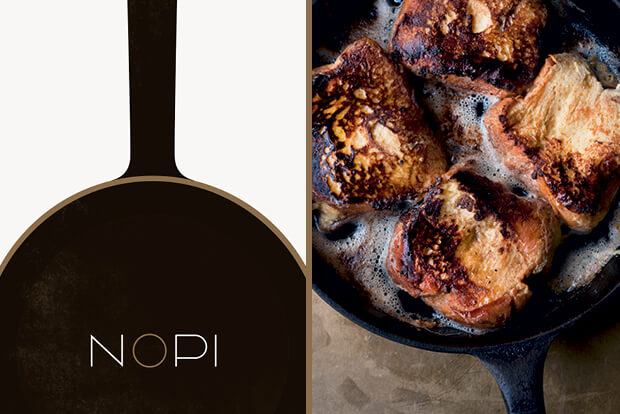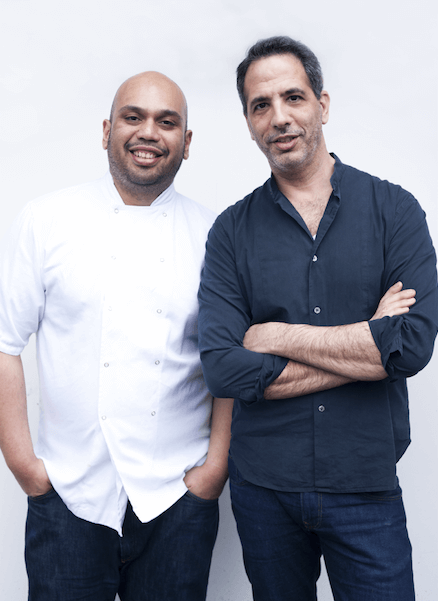Chef of Plenty: Talking with Yotam Ottolenghi about Nopi, Restaurant- versus Home-Cooking, and What He’d Eat for His Last Meal


NOPI French Toast
Photo: Jonathan Lovekin
Here’s a funny thing that’s happened to me on numerous occasions the last few years: Any time I’d ask for the recipe of a dish that I’d loved at a dinner party or gathering, the answer would invariably involve one of Yotam Ottolenghi’s cookbooks. Ottolenghi, who operates several restaurants in London, has swept the cookbook world with titles Jerusalem, Plenty, and Plenty More, all filled with irresistibly delicious, vegetable-forward food that manages to be both easy enough for the amateur home cook to attempt, as well as inventive enough for those with the most discerning palate to enjoy. Now, Ottolenghi is out with a new cookbook, but this one has a slightly different bent. NOPI is a collaboration with Ramael Scully, the executive chef at Ottolenghi’s restaurant NOPI, and features recipes that are a touch more complex (though still approachable for the home cook), and that clearly bear Scully’s influence, what with the inclusion of ingredients like tamarind, pandan leaves, and miso. What remains consistent is the through-line that exists in all Ottolenghi’s books, namely, an abundance of the type of food that any of us would happily devoir, time and time again. Plus: lots of gorgeous food-porn photography.
Below, Ottolenghi tells us more about collaborating with Scully, what it’s like to be a perfectionist, and what—and with whom—he’d eat for his last meal.


Ramael Scully and Yotam Ottolenghi
photo by Jonathan Lovekin
How was it to work on NOPI collaboratively, with Ramael Scully? What things do you learn from each other?
It was epic! All books are so different from each other, all with such different focuses, challenges and things to get your head around. Scully and I are really different in lots of ways: I’m a stickler for time keeping and a horror of being late, for example, something which Scully is blissfully (and often frustratingly!) ignorant of. We also each bring our own pantries and cooking vocabulary, as it were, to the kitchen when we come together to cook. Scully’s years in the restaurant kitchen means that he’s all about the three day marination with tons of ingredients whereas I (because I spend most of my time developing recipes in the test kitchen for the home cook) am more used to always thinking through the practicalities and logistics of a recipe from the point of view of the home cook. I never compromise a recipe to make it simple for the sake of it but, at the same time, there is a difference between someone who does most of their cooking for the restaurant visitor and someone who does most of their cooking for the person cooking in the evening or on the weekend at home.
At the same time as both being utter perfectionists, though, there was really never any ego or tension in the kitchen when a dish was being tested and re-tested (and often simplified) for the home cook. It’s very easy for chefs to be hugely protective of their recipes–they don’t want anything less than the best being sent out, whether it’s over the pass or in the pages of a recipe book–so I’ve got huge admiration for how Scully saw some of his dishes change in the process of writing the book. We have always talked through the original ‘master’ recipe for those who want to go the extra mile, though.
I’ve learnt so much from Scully and have been exposed to so many ingredients that he has brought into the kitchen: the pandan and banana leaves, the miso and tamarind, the star anise and rasam broths—that’s all Scully. And what Scully’s learnt from me? That sometimes less can be more with a dish–it doesn’t always need four or five elements to work. And to show up on time!
What excites you when you’re planning recipes? What things still feel fresh at this point in your career?
I’m constantly amazed by how it all still somehow feels fresh, however many recipes I have under my belt. The seasons keep coming around and then there is always a new ingredient I want to try out–I want to get more vermouth into my cooking at the moment, for example and also juniper berries: I had them in a yogurt mint ice cream recently and there was something so special and woodland-y about it that I want to have a play around with.
As well as getting excited by the new, when planning a recipe, I get just as excited by the familiar. I realised the other day that I haven’t been cooking nearly enough with leeks, for example, so I had a brain storm of ways to shed a new light on this most familiar of ingredients.
One of the most beloved traits of your cookbooks has been their accessibility; the recipes in Nopi are a bit more complicated, though. How are they still accessible to the amateur chef?
This was the biggest challenge for the NOPI book and one that I really feel like we pulled off. Each and every recipe went through numerous tests and re-tests as we experimented with how any complicated restaurant techniques could be adapted for the home cook–there is no need for any fancy equipment like thermos mixers in the book – or whether any elements of a dish could be set aside (or just offered as an additional extra) without compromising the end result. It was illuminating, in fact, to see how many dishes could work without all the elements we deem necessary in the restaurant and how many processes can be simplified. In every case where an alternative (simpler version) is offered, we always talk through how it would be done in the restaurant, though, for the home cook who really wants to go that extra mile and make a dish exactly like it is served at NOPI.
What’s the difference to you between “restaurant cooking” and “home cooking”?
In a restaurant, chefs spend hours before service prepping and chopping all the food so that it is ready to put together when the order comes through. This mise-en-place–having everything in place so that you can just go ready-steady-GO when the time comes–can take all morning. At home, obviously, the process is very different and people often don’t have or want to spend the best part of day preparing for a meal that is going to feed just four. Techniques need to be simpler, quicker, ingredients lists need to be shorter to reflect the fact that home cooks don’t always have the stocked shelves on tap in restaurants. The NOPI book does ask for a certain state of mind, though, and it is often useful to have everything chopped and weighed out and ready to go before you start cooking: it makes the process much more relaxing anyway, knowing you just have to add it to the pan at the right time.
The process of being a guest in a restaurant and at home is also very different: in a restaurant people don’t mind a chef who is single-mindedly focussed on the cooking–it’s what they’ve paid for, in fact–but at home people’s expectations are different: guests would far prefer a relaxed chef and a simple meal than a stressed out cook and some overly-complicated feast!
What recipes in this book are the ones you turn to when cooking at home for yourself? Which ones would you recommend to someone just starting to cook at home?
We have included a list at the back of the book of some of the dishes which are relatively simple stand-alone suppers–the lamb meatballs, for example, or pearly barley risotto–as well as suggestions of dishes which work together if you want to push the boat out a bit more and re-create a NOPI style feast.
Lots of the NOPI recipes work really well for dinner parties, though, as you can often do so much of the work and preparation in advance and then just put the dish together before serving. A great and simple dinner party main course I cook a lot is the buttermilk cod with urid dal: it’s super simple but with a real in-built ‘wow’ factor that is fun when you are entertaining.
I would really urge people not to be intimidated by any of the dishes, though: this is not about pretending you are a chef in a busy restaurant dishes out different orders for different customers–this is food you can prepare well ahead of time, relax in the knowledge that the work is done and tastes delicious and then just put it together when you are ready to eat.
Your food is renowned for being fresh, market-driven, and vegetable-oriented, but some avowed meat-eaters are still scared by the prospect of meatless meals (to say nothing of meatless lifestyles). What would you say to try and sell a vegetable-focused diet to them?
If people want ‘meaty’ vegetables then cooking with things like mushrooms and aubergines is a great place to start. Coupled with some umami-rich ingredients like parmesan, miso, black garlic, tamarind and so forth – all these are great ways of injecting tonnes of savoury flavour into your vegetable-focussed cooking – the feel of eating these sorts of things really is as rich and hearty as a lot of meat.
There is such an incredible abundance of choice and range and flavor in all the choice offered by a vegetables-focussed diet so I would just urge people to turn up the oven, get out the olive oil, have some flavorful herbs, spices or spice and nut mixes to hand–dukkah is a favorite of mine, the Egyptian condiment of toasted and ground nuts and spices–to add flavor and crunch–and get cooking.
Final Question: What would you eat for your Last Meal, and who else would you want to be at the table with you?
It would be a big bowl of fresh pasta with a simple tomato sauce in my kitchen at home with Karl and our two little guys: never happier.
Recipe: French Toast with Orange Yogurt (Serves Six)
Having sold the Super French Toast that appeared in Yotam’s Plenty More as pretty much the definitive word on the matter, we momentarily questioned the inclusion of another French toast recipe here. It’s such a brunch favorite of our NOPI regulars, though, that we weren’t allowed to leave it out.
Orange yogurt
1/2 cup/150 g Greek yogurt
finely grated zest of 1/2 orange
1 tbsp orange juice
1 tbsp confectioners’ sugar
Mixed berries
10 1/2 oz/300 g mixed frozen berries
1/3 cup/70 g superfine sugar
2 tsp lemon juice
Star anise sugar
8 whole star anise, blitzed in a spice grinder into a fine powder
1/4 cup/50 g superfine sugar
French Toast
5 eggs
3/4 cup/200 ml whole milk
14 oz/400 g brioche loaf,
ends trimmed, cut into six (1 1/4-inch/3-cm) slices
1/3 cup/80 g unsalted butter, fridge-cold, cut into
3/4-inch/2-cm dice
Fold together all the ingredients for the orange yogurt in a small mixing bowl and keep in the fridge, covered, until required.
Place the berries in a medium saucepan with the sugar and lemon juice. Place over high heat and cook for 6 minutes, stirring from time to time, until the sugar has dissolved and the compote is shiny and thick. Remove from the heat and set aside for an hour to come to room temperature; the compote will thicken slightly.
Mix together the star anise and sugar, then spread out on a small plate—ready for the toast to get dusted—and set aside.
Place the eggs in a medium bowl and whisk well, until pale, light, and fluffy. Continue to whisk as you slowly pour in the milk, then transfer to a dish that is large enough to fit the 6 slices of brioche in a single layer—use two dishes if you need to. Add the brioche slices and set aside for 5 minutes, turning them once or twice. It will seem like a lot of liquid for the bread to absorb, but it will do; just be careful when you are turning it, as it gets very soft.
Preheat the oven to 465°F/240°C (425°F/220°C convection).
Place a large nonstick frying pan over medium-high heat with 4 teaspoons/20 g of butter. When the butter starts to foam, lay 3 pieces of brioche in the pan and fry for 1 to 2 minutes. Flip the slices over, add 4 teaspoons/20 g more butter to the pan, and continue to fry for another 1 1/2 minutes, until golden. Remove the slices from the pan and set aside on a baking sheet while you wipe the pan with some paper towels and repeat with the remaining brioche and butter. Once all the brioche is on the baking sheet, transfer to the oven and bake for a final 4 minutes, until the toast has puffed up and is golden brown. Remove from the oven and dip each slice in the star anise sugar one at a time, flipping so that both sides get coated.
Serve at once, with the berry compote alongside and the orange yogurt spooned on top.
Reprinted with permission from NOPI: The Cookbook by Yotam Ottolenghi and Ramael Scully, copyright © 2015. Published by Ten Speed Press, an imprint of Penguin Random House LLC.
You might also like 




















